Chongqing - Yangtze River Three Gorges Cruise - Yichang Seven and a Half Day Free Tour
1、 Travel route planning before departure:
For this trip, our family of three and another father and daughter, totaling five people. Through Ctrip, book air tickets from Beijing to Chongqing (1260 yuan/person), hotels (Crowne Plaza Monument to the people's Liberation, Chongqing, 548 yuan/room; Yi Jin Mei Yi Hotel, Yichang, 239 yuan/room), and half day trips to Qu Yuan's hometown (110 yuan/person); Book a one-day trip to Dazu through other platforms (238 yuan/person), a 4-day 3-night cruise from Chongqing to Yichang (2286 yuan/person, with a complimentary one-day trip to Chongqing city, and a balcony river view room on the third floor of the Golden No.1 cruise ship with an extra bed); Book a high-speed rail ticket from Yichang to Beijing at 12306 (630 yuan/person).
1. On July 20th, Beijing to Chongqing, flight CA1439 departed from Beijing Capital Airport T3 at 13:20 and arrived at Chongqing Jiangbei Airport T3 at 16:15. Stay at Crowne Plaza Monument to the people's Liberation Chongqing in the evening.
2. On July 21, a one-day tour of Dazu Rock Carvings in Chongqing. Follow the local tourist group in Chongqing, expected to depart at 7am and return to the hotel around 5pm. Arrange your own breakfast and dinner. There is a group meal for lunch. The main tourist attractions include Changzhou Ancient Town, Beishan Stone Carvings, Stone Carving Museum, and Baoding Mountain Stone Carvings.
3. On July 22nd, a one-day tour was held in Chongqing, with main attractions including the Yangtze River Cableway, Zhazidong, Baigongguan, Ciqikou, Liziba Light Rail Station, Chongqing People's Great Hall, Three Gorges Museum, Zhou Gongguan No. 50 Zengjiayan, and Hongyadong. Depart around 7am, check out, bring your luggage on board, and deliver to the cruise ship dock around 6pm. Arrange breakfast, lunch, and dinner on your own. A one-day tour within the city is a gift from a cruise company. Boarding the cruise ship before 8 pm that evening.
4. From 8pm on July 22nd to 1:30pm on July 25th, the cruise ship will depart from Chongqing to Yichang. Regarding the activities on the cruise ship, we can discuss them on board. The main self funded projects include: 1. Visiting the Shibaozhai in Zhongxian County or the performance of the Three Kingdoms (290 yuan/person); 2. Fengjie Baidi City (290 yuan/person); 3. Small Three Gorges Drifting (150 yuan/person); 4. Passing through the Three Gorges Dam ship lock (290 yuan/person).
5. From 2pm to 6pm on July 25th, visit Qu Yuan's hometown and stay at Yijin Meiyi Hotel in Yichang in the evening.
6. On July 26th, the high-speed railway from Yichang East Station departed at 8:18 and arrived at Beijing West Station at 16:46.
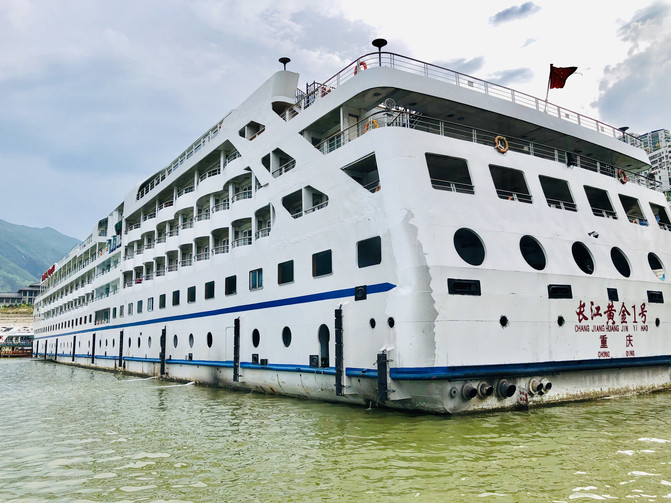
2、 Travel
1. Chongqing (July 20th to July 22nd)
This summer, Chongqing is almost cloudy and rainy every day, and the weather is relatively cool. Due to weather conditions, we started monitoring the weather in Chongqing and our scheduled CA1439 flight one week before departure, which was delayed every day until July 20th. We were lucky that the flight not only didn't arrive late, but also arrived 20 minutes early. Due to our group of 5 people being unable to fit into a small car, I politely declined my classmate's request to come and pick us up at the airport. We took a taxi to the hotel ourselves, with a fare of 50 yuan. In the evening, my classmate and fellow villager Deng welcomed us at Qiaobayu in Shiqiao Square, and my college roommate Lao Ren also attended. In the evening, the staff of the one-day tour of Dazu Rock Carvings in Chongqing called and told us to pick us up at the hotel at 6:50 tomorrow morning.

At 6:50 on July 21, the driver picked us up on time to visit Dazu Rock Carvings. Today's tour guide was very professional and had a good service attitude. Chongqing's hotpot is the most famous. The tour guide introduced us to the origin of Chongqing hotpot: Chaotianmen, located at the confluence of the Yangtze River and Jialing River in Chongqing, was originally a place where Hui people slaughtered livestock. After slaughtering cattle, Hui people only wanted the meat, bones, and skin, but discarded the internal organs. Sailors and boatmen on the shore picked them up, washed them, poured them into a pot, and added spicy ingredients such as chili peppers, Sichuan peppercorns, ginger, garlic, salt, etc. They boiled and ate them. This not only satisfied the stomach, but also drove away cold and dampness. Over time, it became the earliest and most famous spicy tripe hotpot in Chongqing. Therefore, Chongqing's hotpot originated from Chaotianmen Port. Passing by the Liziba Light Rail Station (a popular check-in spot), he also introduced us to the relevant situation. People are generally concerned about whether the light rail or the building came first. In fact, these two were built at the same time, and there is no problem of who came first and who came later. The light rail passes through the building in Chongqing, a mountain city, and it is a construction method that was done out of necessity. It saves land and is built along the mountain, so it is unique. Although the light rail passes through buildings and vehicles travel back and forth countless times a day, it does not significantly affect the lives of residents upstairs because it produces very little noise. The development of modern technology provides a guarantee for this construction method.
The first stop today is Changzhou Ancient City. Changzhou Ancient City is an artificial landscape built in imitation of Changzhou City in the Song Dynasty. The city restores the bustling streets of the Song Dynasty, such as government offices, temple neighborhoods, hundred ancestral halls, handicraft workshops, stage and theater buildings, inn snacks, etc., making people feel as if they have traveled back to Changzhou City in the Song Dynasty. But there are not many tourists here and the popularity is not high. We walked for about 20 minutes in Changzhou Ancient City and returned to the car. It can be seen that later artificial landscapes did not attract the attention of tourists.


The second stop is Beishan Stone Carving. The Beishan stone carvings were excavated between 892 and 1162 AD, and the cliff face of the statue is about 300 meters long and 7-10 meters high. Divided into two sections: south and north. 1-100 is the southern section, and 101-290 is the northern section. There are nearly ten thousand statues carved on the cliffs of Beishan, mainly funded by individuals (ordinary people) at that time. It showcases the development and changes of folk Buddhist beliefs and stone carving styles in China.

The third stop is Dazu Rock Carvings Museum. We have learned that there are currently ten grottoes listed on the World Cultural Heritage List worldwide. There are three in India, one in Afghanistan, and six in China. The Mogao Grottoes of Dunhuang in Gansu, Kizil Grottoes in Xinjiang, Maijishan Grottoes in Tianshui, Gansu, Longmen Grottoes in Luoyang, Yungang Grottoes in Datong and Dazu Rock Carvings. There are over 50000 stone sculptures in Dazu County, distributed in more than 70 locations within the county. The five cave groups of Baoding Mountain, Beishan Mountain, Zhuanshan Mountain, Shimen Mountain and Nanshan Mountain are called "Dazu Rock Carvings" by the world, of which the largest ones are Baoding Mountain Rock Carvings and Beishan Rock Carvings, and tourists mainly visit these two rock carvings. In 1999, Dazu Rock Carvings was included in the World Cultural Heritage List, competing with Yungang Grottoes and Longmen Grottoes.
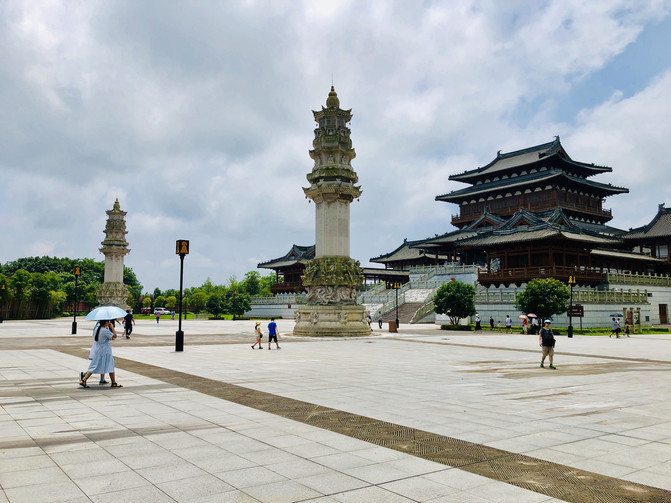

The fourth stop is the Baoding Mountain stone carvings. At that time, the Beishan stone carvings were mainly funded by individuals, while the Baoding Mountain stone carvings were funded by the government. The stone carving of Baoding Mountain began during the Southern Song Dynasty, and Buddha statues were carved all over the rocks within 2.5 kilometers around it. Dazu Dafu Bay is the main body, followed by Xiaofo Bay, distributed on the east, south, and north sides. There are over 360 giant sculptures, among which the Six Paths of Reincarnation, the Great Treasure Pavilion, the Three Holy Statues of Huayan, and the Thousand Armed Guanyin statue are the most famous. The tour guide gave us a detailed introduction to the Six Paths of Reincarnation, the Great Treasure Pavilion, the Three Holy Images of Huayan, the disguised form of the Hell, the disguised form of the Parents' Grace Sutra, and the Thousand Armed Guanyin statue. These stone carvings reflect the level of stone carving art at that time.



Today's weather is cloudy and the temperature is not high. Lunch was a group meal at a local farmhouse, with a good taste and a satisfying meal. Free mineral water was also provided, which can be taken away. Around 5pm, we finished our itinerary for the day and returned to the hotel. In the evening, Lao Deng invited us to have hotpot, while Lao Ren and my university classmates from Chongqing invited me for a meal. I was helpless. Fortunately, we are a team of five. I went to attend a classmate dinner, while the other four went to eat hotpot. I received a phone call and text message from a one-day tour staff in Chongqing at night, confirming that the tour guide will come to the hotel to pick us up for the day tour at 7:15 tomorrow.

On July 22nd, we checked out early and the tour guide came to the hotel on time to pick us up for a one-day trip to the city. Today's tour guide was thin and good-looking, a typical Chongqing girl. We put our luggage on the bus, which had about 40 passengers participating in the one-day tour. The tour guide also introduced us to the origin of Chongqing hotpot, just like what the tour guide introduced yesterday. Today's tour guide also told us that the Jialing River is turbid and the Yangtze River is clear. The two rivers meet at Chaotianmen, one is clear, the other is muddy. Chongqing calls it "Double-flavor hot pot". It's a pity that it's rainy season and the water in the Yangtze River is muddy. We can't see the scene of "Double-flavor hot pot", so we feel a bit sorry.
The first and only self funded project we visited today is the Yangtze River Cableway, which costs 20 yuan per person for a one-way trip and 30 yuan per person for a round trip. We volunteered to participate, and more than 40 tourists on board participated. There are many tourists taking the cableway and they need to queue up. We arrived early and waited in line for about half an hour. Due to the fact that visiting Zhazidong and Baigongguan is free and requires online booking, the tour guide used our queue time to teach everyone how to make appointments online on their mobile phones. Some elderly people may not know how to do so, but the tour guide patiently helped them make reservations. The five of us had already made an appointment a few days in advance, which made it feel more relaxed. Today, as planned, there was also a self funded project to climb the platform of the highest building in Chongqing to watch the night scene, but it was forced to cancel because of the rainstorm that afternoon.



The third scenic spot we visited today is Ciqikou. We arrived at Ciqikou around 12 o'clock. Ciqikou Ancient Town is a national AAAA level scenic spot, a famous historical and cultural street in China, and a key protected traditional street in Chongqing. It was founded in the Song Dynasty and has a unique landscape of "one river, two streams, three mountains, and four streets", forming a natural harbor. It is an important water and land dock on the Jialing River. Once upon a time, the phrase 'thousands of people bowing their hands during the day, and ten thousand bright lights shining at night' flourished. Ciqikou is actually similar to Nanluoguxiang in Beijing, a pedestrian street with narrow streets. There are various traditional snacks, tea houses, Chongqing specialties, and many ear picking shops on both sides of the street. I originally wanted to experience them, but time did not allow, so I had to give up. The five of us were in a small shop, each ordering our favorite snacks, and lunch was enough. The ice cream here is good, we each ordered a bowl.

The fourth attraction we visited today is Liziba Light Rail Station. Liziba Station on Chongqing Rail Transit Line 2 is the first cross platform monorail elevated station in China that coexists with commercial and residential buildings. It was completed in March 2004. According to the tour guide, it did not attract everyone's attention until 2009 when a tourist from out of town took the light rail and passed by the station, and posted pictures online, which was the "light rail through the building" that everyone saw online. Due to its "aerial train passing through buildings", it has become a well-known "internet famous station" both domestically and internationally. Later, the municipal government also built a viewing platform by the river. The light rail station is located on the 6th and 7th floors of the commercial and residential building at 39 Liziba Zhengjie. The station is designed, constructed, and put into use simultaneously with the building, using a "station bridge separation" structural form. The track station bridge and the commercial and residential building structural support system are set separately, effectively solving the problems of structural force transmission and vibration between the two. Xiao Qin, the tour guide, took us into the light rail station and took two stops from Liziba to Zengjiayan Station. The Zengjiayan subway station is connected to the air raid shelters dug in the late 1960s and early 1970s. It is cool inside and many elderly citizens play Chongqing cards and poker here, which is very leisurely.

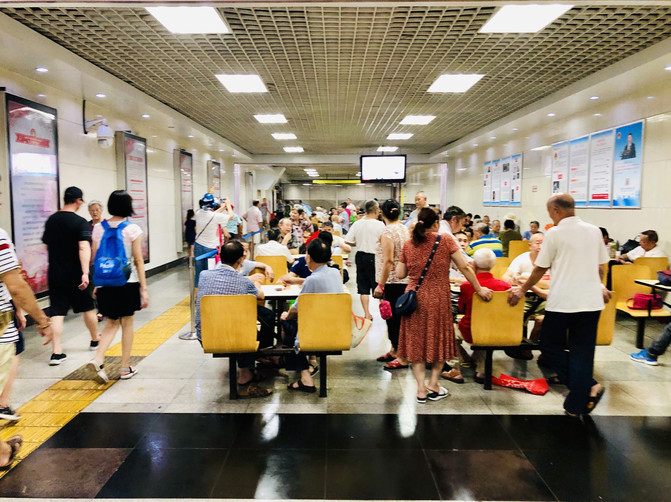
The fifth attraction we visited today is Zhou Mansion at No. 50 Zengjiayan. During the period of cooperation between the Kuomintang and the Communist Party of China, this was the location of some institutions of the Southern Bureau of the CPC Central Committee. Now the Zhou Mansion still maintains its original appearance.
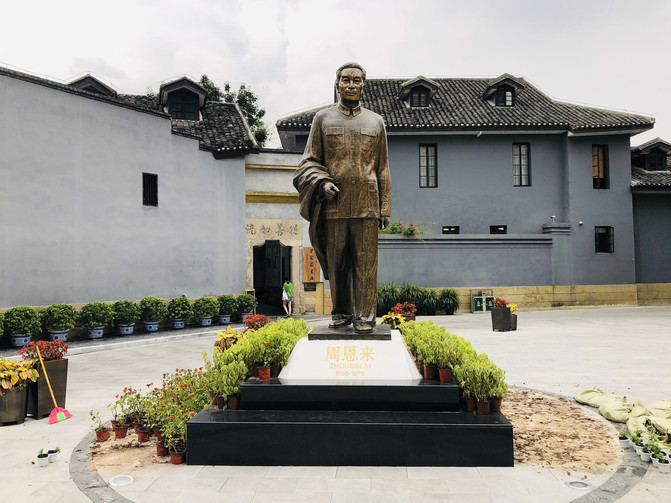

The sixth attraction today is the Chongqing People's Grand Hall. In the early days of liberation, Chongqing was a municipality directly under the central government. It was abolished in 1955 and became part of Sichuan Province. In 1997, it was restored to a municipality directly under the central government. The Chongqing People's Grand Hall was built in June 1951 and completed in April 1954. It is an antique ethnic architectural complex, one of the top ten cultural symbols in Chongqing, and one of the unique landmark buildings in Chongqing. It is also a national AAAA level tourist attraction. The Chongqing People's Great Hall is a magnificent and magnificent architectural masterpiece that cleverly combines the traditional Chinese palace architectural style with the large-span structure of Western architecture. It is renowned both domestically and internationally for its extraordinary architectural art. In September 2016, the Chongqing People's Grand Hall was included in the "First Batch of China's 20th Century Architectural Heritage" list. At about 4 o'clock in the afternoon, we were touring in front of the square of Chongqing People's Great Hall when it suddenly rained rainstorm. Although we were holding umbrellas, our clothes were still wet. Tourists braved the rain and returned to the bus. Due to the heavy rain, the tourists and tour guide reached an agreement to cancel the self funded project of climbing high-rise buildings for sightseeing and the Hongya Cave tour. The nearby Three Gorges Museum was closed on Monday and could not be visited. At the beginning, the tour guide said to disperse the tourists near Hongyadong. Due to the rain, most of the tourists requested to be sent back to the hotel, while our five person group requested to be sent to the dock. Some tourists had arguments with the tour guide. The tour guide was calm in the face of danger. After a phone call, we arranged one by one to let the driver drive the car to the place where we concentrated in the morning near the Crowne Plaza Monument to the people's Liberation. Most of the tourists stayed in the hotel nearby, and they were satisfied with the car leaving. Another six tourists stayed in Jiulongpo. The guide got off and asked a taxi to take them back to the hotel. Only five of us were left on the bus. The guide arranged the driver to take us to the dock 15. Everyone was satisfied. The one-day tour ended in a harmonious atmosphere. At around 5pm, we arrived at Pier 15 and the rain had already eased. We had planned to have dinner near the pier before boarding, but the two children wanted to board first. We got off across the street from the dock and were asking how to get there when a "Chongqing Bang Bang" arrived. The luggage was 10 yuan each, and our four suitcases cost a total of 40 yuan. Before six o'clock, we boarded the "Golden One" cruise ship.



2. Cruise (July 22nd to July 25th)
On the afternoon of July 22nd at around 6 o'clock, we successfully boarded the "Golden One" cruise ship. I went through the procedures in the second floor lobby of the cruise ship, and the waiter led the other four members of the team to the second floor restaurant for rest. At this point, the waiter began to introduce and promote various self funded items on the cruise ship. The main self funded projects include upgrading rooms to higher floors, with an additional fee of 150 yuan per person for each floor upgrade; Catering VIP, can go to the sixth floor for table meals, with an additional charge of 300 yuan per person; You can dine in a private room on the sixth floor, with an additional charge of 500 yuan per person; Go ashore to visit the Three Kingdoms performance in Zhongxian, priced at 290 yuan per person; Visiting Baidi City in Fengjie, 290 yuan/person; Participate in the Little Three Gorges Drifting for 150 yuan/person; Passing through the Three Gorges Dam ship lock, 290 yuan/person. We five discussed and chose to visit Baidi City and Little Three Gorges Drifting. Under the temptation of the waiter, the five of us also purchased a 388 yuan beverage package, promising that each person could choose a bottle of beer or a cup of fruit tea for lunch and dinner, and that the captain's welcome party would allow us to choose the best seats, and so on. The next day at lunch, as soon as we entered the restaurant, we told the waiter that we wanted two bottles of beer and three cups of fruit tea. The beer came quickly, but the three cups of fruit tea didn't come up until we finished eating. Later, we told the waiter that we didn't want this set meal anymore and wanted to return it. Fortunately, it was actually refunded, but we had to deduct 30 yuan for two bottles of beer and 90 yuan for three cups of fruit tea on that day.
The three story river view room we booked is good, with a balcony and complete facilities. The room is relatively large and can even accommodate an extra bed. We had dinner at the restaurant on the sixth floor in the evening, enjoying the night view while eating. It felt great. At around 8pm, the cruise ship began to set sail. We enjoyed the night view on the sixth deck until the lights by the river became increasingly dim, and then we returned to our room to rest.
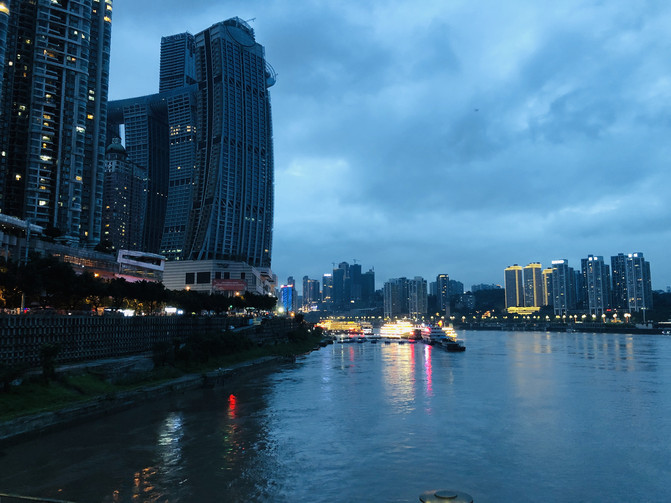

On July 23rd, when I woke up, the cruise ship had docked at the Ghost City Pier in Fengdu. 8: At 30 minutes, the cruise ship staff divided the tourists into several groups of 30-40 people each. The local tour guide organized the tourists to disembark and visit the Fengdu Ghost City Scenic Area. When we disembarked, it was still raining, but the rain was not heavy. We braved the rain to visit the ghost city, which has a history of nearly 2000 years. Guicheng is famous for its various buildings and shapes of Yin Cao Di Fu, and is one of the first AAAA level tourist areas in China. It is a historical and cultural city that originated in the Han Dynasty and is known as the "Capital of the Ghost Country" and "Yin Cao Di Fu", becoming a destination for human souls. We visited several buildings in the Ghost City that depict the underworld, including the Yin Yang Bridge, Hemha Temple, Tianzi Hall, Guimen Pass, Naihe Bridge, Huangquan Road, Wangxiangtai, and Yaowang Hall. At 12:00 noon, we returned to the ship. In the afternoon, the cruise ship left Fengdu Ghost City Pier and docked at Zhongxian Pier for dinner. There is a captain's welcome party this afternoon, which is not long. After dinner, the five of us left the cruise ship and landed in Zhongxian. We took a leisurely walk along the river, feeling relaxed and happy! Before dark, we returned to the ship and rested early. We did not sign up for the evening performance of the Three Kingdoms of War and Smoke.
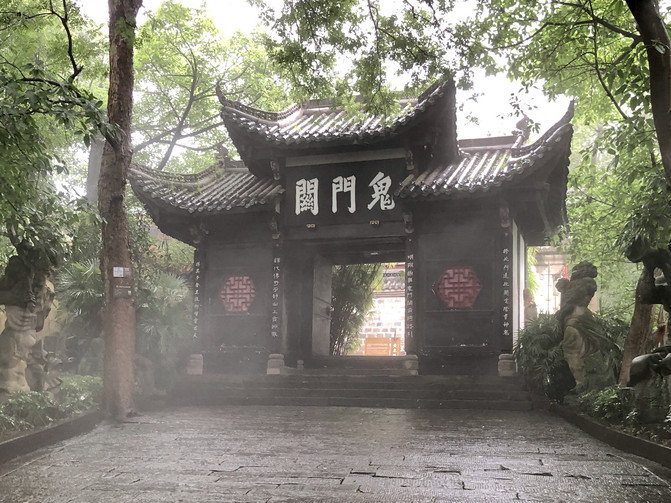

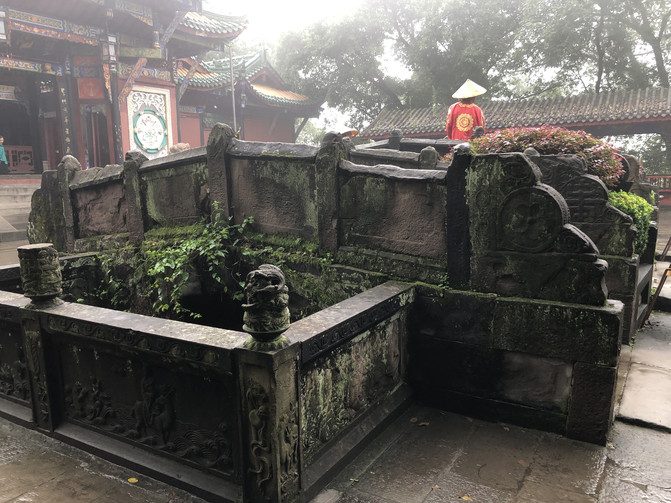

On July 24th, when we woke up, the cruise ship had arrived at the pier of Baidicheng Scenic Area. Visiting Baidicheng was our first self funded project. At 8:15 in the morning, the tour guide took us off the ship to visit Baidi City. As soon as I arrived at Baidi City, I thought of Li Bai's poem "Early Departure from Baidi City". In the morning, I bid farewell to Baidi amidst the colorful clouds, and the thousand mile long Jiangling was returned in one day. The boat passed thousands of mountains with apes shouting without endless. Baidi City is located on the north bank of the Yangtze River at the mouth of Qutang Gorge in Fengjie County. It is a world cultural heritage site, a national key cultural relic protection unit, a national AAAA scenic spot, and is currently applying for an AAAA scenic spot. The original name of Baidi City was Ziyang City, which was built by Gongsun Shu during the late Western Han Dynasty. Gongsun Shu called himself Baidi, hence the name "Baidi City". Baidi City is the best place to observe the grandeur of Kuimen in the world. The background pattern of the current 10 yuan RMB is "Kuimen, the world is majestic". After the construction of the Three Gorges Dam, the water level rose by 90 meters, and Baidi City was flooded by two-thirds, leaving only one-third. Currently, Baidi City is an isolated island in the Yangtze River. Fortunately, the scenery of Baidi City is all on the mountaintop and has not been submerged by the river. We mainly visited the Bai Di Temple, Tuogu Hall, Bai Lou, and Guankuimen scenic spot. According to the tour guide, the White Emperor Temple used to enshrine Gong Sunshu. In the 20th year of the Jiajing reign of the Ming Dynasty (1533), the statue of Gong Sunshu was removed and replaced with a statue of Liu Bei. Famous poets throughout history, such as Li Bai, Du Fu, Bai Juyi, Liu Yuxi, Su Shi, Huang Tingjian, Fan Chengda, and Lu You, have all climbed to Baidi City and left behind a large number of poems. Therefore, Baidi City is also known as the "City of Poetry". After visiting Baidi City, return to the cruise ship at 11:15 and wait for the ship to set sail to admire Qutang Gorge.



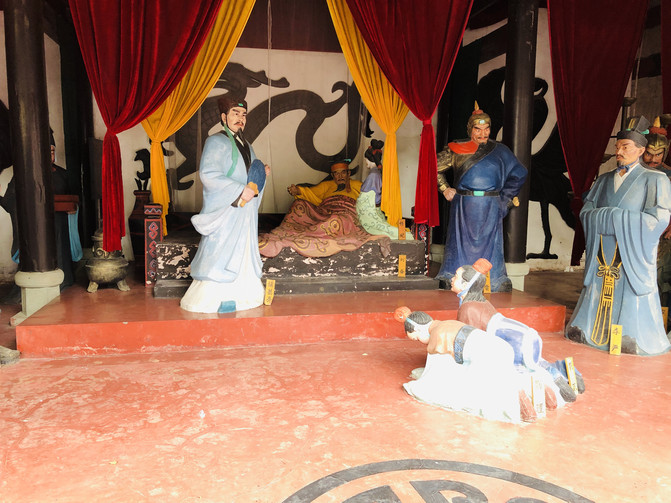


At 1:45 pm, switch to a medium-sized boat to tour the Little Three Gorges. Wushan Xiaosanxia is the general term for Longmen Gorge, Bawu Gorge, and Dicui Gorge that flow through Wushan in the lower reaches of the Daning River; These three canyons have a total length of 60 kilometers. This season, the water in the Yangtze River is turbid, but when it enters the Daning River, the water becomes clear. In the morning, it was still cloudy, but as soon as we entered the Daning River, the weather was beautiful, with blue skies and white clouds, coupled with green mountains and water, and the scenery of the Three Gorges, it was a feast for the eyes. Tour the Little Three Gorges for about 40 minutes. After crossing the Dicui Gorge, switch back to a small wooden boat and explore the Little Three Gorges again. The Little Three Gorges is the second self funded project we participated in. Participants switch to small wooden boats to visit the Little Three Gorges, while those who did not participate in the project wait on medium-sized boats.






Wushan Xiaoxiaosanxia is located on the Madu River, a tributary of the Daning River at the Dicui Gorge. It is a general term for Changtan Gorge, Qinwang Gorge, and Sanjiang Gorge. Before the construction of the Three Gorges Dam, the Madu River was just a small stream, but now it has become a river several tens of meters deep. We visited the Little Three Gorges, with towering mountains on both sides, straight up and down. However, even on such steep cliffs, there are still residential houses that are said to have been inhabited by medicinal gatherers in the past. There is also an ancient house on the cliff, which is said to have been built by a student in ancient times. In order to prevent interference, he chose to build a house here to study hard and concentrate. In the end, this student finally passed the imperial examination and became a scholar. On the cliffs of Xiaosanxia and Xiaosanxia, one can also see the eternal mystery of hanging coffins.
After visiting the Little Three Gorges, we returned to the cruise ship and it was already past 6 pm in the afternoon. 6: Around 30, the cruise ship entered Wu Gorge and we arrived on the fifth deck to enjoy the scenery of Wu Gorge. Seeing the scenery of Wuxia, I couldn't help but think of it Li Daoyuan Famous quote:“ The Three Gorges Wu Gorge in Badong is long, with three cries of monkeys and tears touching one's clothes Unfortunately, we couldn't see monkeys or hear their calls on the cruise ship, but we occasionally saw monkeys while visiting the Little Three Gorges. At 7 pm, there is a captain's farewell dinner on the cruise ship, which is quite sumptuous.




On July 25th, at 8am, we left the cruise ship with our luggage. Since we did not register to experience the Three Gorges Dam ship lift, the tour guide took us directly to visit the Three Gorges Dam. The Three Gorges Dam is the largest construction project in China's history. The Three Gorges Dam mainly has functions such as power generation, flood control, and navigation. The annual power generation of the Three Gorges Dam exceeds 100 billion kilowatt hours, making it the world's largest hydroelectric power station in terms of installed capacity. Visiting the Three Gorges Dam is free, but it is necessary to hold valid identification and pass through security checks. There are two main attractions to visit when visiting the Three Gorges Dam. One is Tanziling, which offers a panoramic view of the dam and a close-up view of the five level ship lock; The other is the 185 platform, which allows for a close-up view of the Three Gorges Dam. The Three Gorges Dam releases floodwaters before the flood season every year. According to the tour guide, the flood discharge period is very spectacular, but unfortunately we did not see any flood discharge.


After visiting the Three Gorges Dam, the bus will take the tourists on the cruise ship to the tourist center in Yichang city. As we planned to visit Qu Yuan's hometown in the afternoon, we contacted the staff of the already booked half day tour of Qu Yuan's hometown in advance. The original plan was to depart from Yichang Tourist Center around 2:30 pm, but the Three Gorges Dam is very close to Qu Yuan's hometown, so we didn't need to go to the tourist center. We got off at the Liushuwan Transfer Center and the driver came to pick us up, saving us nearly 3 hours. Before 12 o'clock, the driver took us to the entrance of Qu Yuan's hometown scenic area, where the tour guide was waiting for us.
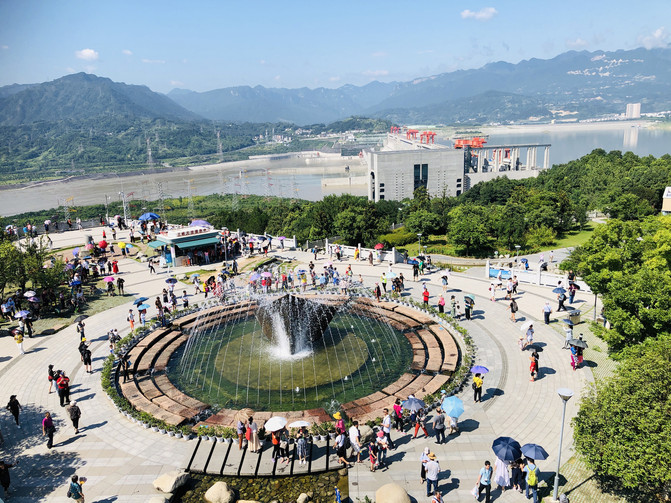

At the entrance of Qu Yuan's hometown scenic spot, there are many characteristic snack shops with many varieties and cheap prices, including various noodles, Rice noodles, hot and sour noodles, and fried rice. Around 1 pm, the tour guide took us to visit the Qu Yuan Hometown Scenic Area. The Qu Yuan Temple is the most important component of the scenic area. The original site of the Qu Yuan Temple was located at "Qu Yuan Tuo" five miles east of Guizhou City in Zigui. It was built in the Tang Dynasty and renamed "Qinglie Gong Temple" in 1080. In July 1976, due to the construction of the Gezhouba Water Conservancy Project, it was relocated to Guizhou and renamed "Qu Yuan Temple". Nowadays, due to the construction of the Three Gorges Dam, the newly built Qu Yuan Temple is located on the mountain ridge of Fenghuang Mountain, facing southeast and opposite to the front of the Three Gorges Dam. According to the plan, the tour of Qu Yuan's hometown took about an hour and a half, but today's tour guide took us on a two-and-a-half-hour tour.
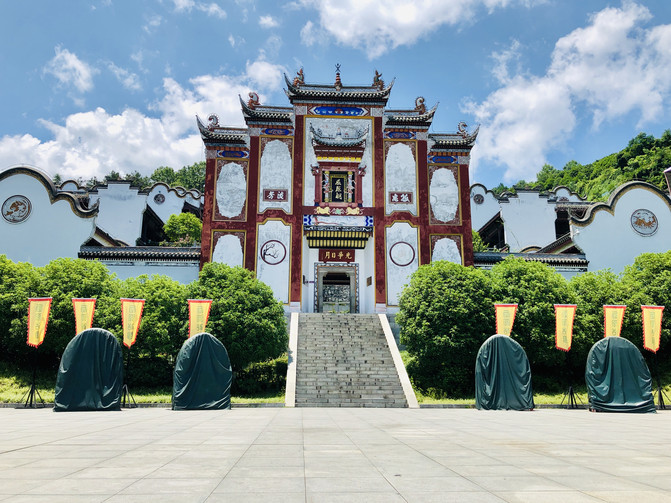
Appearance of Qu Yuan Temple

Qu Yuan Temple in the Qing Dynasty

Qu Yuan Temple in the 1970s

The current Qu Yuan Temple

The cave where Qu Yuan studied

A corner of Qu Yuan Temple
We returned to the pre booked Yijin Meiyi Hotel in Yichang at around 5pm in the afternoon. Take a walk to Yichang Binjiang Park in the evening, walk along the Yangtze River bank, enjoy the night view of Yichang, and feel relaxed. On the 26th, I successfully returned to Beijing by high-speed rail as planned, ending this pleasant trip.

Night view of Yichang Binjiang Park
Conclusion:
For this trip, a large number of guides were consulted on platforms such as Ctrip before the trip. Through service comparison and price comparison, a detailed travel route was developed. Transportation, accommodation, one-day tours, customized cruise ships, tourist attractions, etc. Although it took a lot of effort, it was definitely worth it. Thanks to the detailed plan, this trip went smoothly, both relaxed and enjoyable! The daily activities are well connected, and the travel projects booked through online platforms have a good service attitude.
Previous Article:First Time Roaming in Magical Chongqing Check in Guide "Two Days and One Night"
Next Article:Revisiting Chongqing | Walking the Way You Came Here
